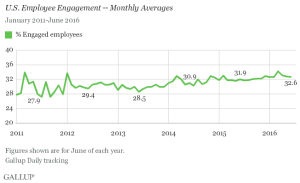Millions of words have been written about employee engagement, and over a billion dollars is spent annually in the US alone on employee engagement surveys and improvement interventions. Yet the needle has essentially not budged in over 15 years.
In The Worldwide Employee Engagement Crisis by Gallup, the authors state:
- “Though there have been some slight ebbs and flows, less than one-third of U.S. employees have been engaged in their
 jobs and workplaces during these 15 years.”
jobs and workplaces during these 15 years.” - “Employee engagement has barely budged in years.”
- “Measuring engagement isn’t sufficient to improve it.”
While there are many reasons why employers’ attempts at increasing employee engagement fail, I see three major factors:
- Execution flaws
- Paradigm flaws
- Courage flaws
Execution Flaws: The classic engagement fail
Put a group of human resource professionals in a room and ask them if they have been reluctant and frustrated co-conspirators to any of the following and you will get almost universal head nods:
1. Employee engagement survey results remain a mystery — This has to be the most extreme and morale-damaging outcome to conducting an employee engagement survey; not reporting the results to the workers. Not only does it communicate “Your input doesn’t really matter, nor do we care about you” it also fosters a sense of learned helplessness, where employees stop even trying to make a difference or show initiative.
2. The results are reported, but aren’t acted upon — While not as overtly disrespectful as not even reporting the results, this employee engagement fail also fosters learned helplessness.
In this mode, employees become less interested in speaking up about anything. They no longer bother to share ideas for process improvements or point out the presence of productivity-diminishing obstacles that could easily be removed if management were aware of them. “Why speak up, it won’t make a difference?” becomes the mantra in organizations that do this.
3. Improving engagement is seen as an “HR thing” rather than an “everybody’s thing” — Seeing engagement as HR’s responsibility and the HR department as the “Engagement Police” whose job is to hassle managers and keep them from their “real work” is a guaranteed way to ensure failure at increasing engagement.
Everybody plays a role in employee engagement, from the CEO to individual contributors. Each needs to understand their role, take responsibility for it, and be held accountable. Human resources needs to be seen as a facilitator of engagement, not the driver.
4. “Solutions” such as fun committees, employee appreciation days, and other goodies, gimmicks, and gala events are seen as the answer — This is very much “The American Way” when it comes to just about any issue related to employee morale, motivation, or engagement.
The default response to problems in any of these areas is typically finding the latest flavor of the month management fad, or perk extracted from a “Best Places to Work” list, and applying it to their workforce.
To appreciate the folly of such an approach, consider this analogy from Are You Really Serious About Improving Employee Morale?:
Imagine the following scenario: a co-worker tells you his wife just told him she’s unhappy with their relationship. He does not remember the exact reasons she stated for her unhappiness, but he does remember her saying she’s unhappy and thinking about leaving.
“I’ve come up with my game plan,” he tells you, bursting with determination and optimism. “But, I need your feedback on which option is the best. I’m trying to decide whether to buy her a BMW, take her on a cruise, or remodel the kitchen. Which do you think would make her happier?”
Now, if those are his potential solutions, might you have some clues about why his wife isn’t happy?
When HR and management respond to employee engagement survey results by establishing a “Fun Committee” or “Dress Down Fridays” or organizing an “Annual Employee “Appreciation event, they not only waste time, energy, and resources, but they can even make the problem worse.
Throwing goodies, gimmicks, and gala event “solutions” at employee engagement problems communicates to employees:
- “Management just doesn’t get it.”
- “Management isn’t really serious or sincere about doing anything about this issue.”
To identify the real solutions to improving engagement — actions that will actually make a difference — requires recognizing the paradigm flaws that keep most organizations from addressing engagement effectively.
Paradigm flaws that lead to flawed, or non-existent results
Engagement surveys, even with comments, give you only the tip of the iceberg — When employee engagement surveys are seen as the be-all-and-end-all source of important information, employers miss out on a huge amount of valuable, actionable information that can only be elicited through in-depth, one-on-one interviews. Furthermore, these interviews can enable you to:
- Target A-list talent in hard-to-fill positions for intel on what’s most important to them, and whether they are getting it in your organization.
- Gather useful information about managerial/employee moments of truth that are impacting employee engagement and productivity.
- Identify bright spots — i.e. examples of managers and departments where employee engagement is high — and identify what practices are creating these positive conditions, and spread these throughout the organization.
- Gather stories you can use in your employer branding and new hire orientation
Employee engagement is viewed as a statistic rather than an individual experience — When conducting surveys and poring over the results, it’s easy to see engagement in terms of organizational and divisional statistics. It’s easy to think in terms of statistical averages rather than the fact that employee engagement is an individual experience.
For instance, if Justin doesn’t feel a sense of meaning and purpose on the job, or believe his boss cares about him as a person, it doesn’t offer him any solace to know that, on average, most employees in his organization feel this way. That statistic doesn’t affect his engagement.
Also, each employee has their own employee engagement recipe, including their own unique combination of engagement drives, de-motivators, and preferred feedback style.
The only way to create high engagement in each employee is to customize the engagement experience, which includes customizing one’s management approach. As Marcus Buckingham puts it, “Average managers play checkers, while great managers play chess.”
In other words, great managers don’t use a “one size fit’s all” approach to management; they tailor their approach based on each person’s unique personality and engagement recipe.
It’s about the conversation, not the survey — Because employee engagement is an individual experience and each employee has their own unique employee engagement recipe, the answer to improving engagement is for managers and employees to have employee engagement customization conversations and “Help Me Help You Help Us” conversations.
The conversation needs to be ongoing, because the employee experience is ongoing — Returning to the use of analogies in our personal lives, imagine having a once a year “Marriage Satisfaction Survey” where each partner fills out a survey form. They discuss their results, and then don’t have another meaningful conversation until the following year’s survey. How well would that strategy work?
It works just as well when it comes to employee engagement. Engagement is a dynamic, changing phenomenon that needs to be addressed as such.
Furthermore, some of the most important data can only be accessed soon after the experience. So for instance, take an important manager/employee moment of truth involving how the manager responded to the employee’s idea or gave feedback, and how that affected the rollout of a project. Many nuances that could make a discussion of this helpful to both manager and employee will be forgotten after a few weeks, let alone months.
Making ongoing manager/employee conversations the primary source of engagement information also addresses two of the biggest sources of employee engagement — especially among millennials:
- Believing your manager cares about you as an individual.
- Feeling your manager actively shows an interest in your professional development (i.e. they work with you on it).
Courage flaws that lead to hiding behind surveys
Most people find giving and receiving feedback anxiety-producing. Most managers would choose checking excel spreadsheets for errors over having to discuss difficult issues with an employee.
Anybody who has been in the work world for any length of time has witnessed, if not directly experienced, how letting fear trump doing what’s right ends up resulting in toxic people and toxic cultures destroying morale and compromising productivity.
Hiding behind a survey to gather data rather than being willing to face one’s anxiety about having candid conversations, is one example of Conversational Cowardice that has huge repercussions.
That being said, merely admonishing or requiring managers to have ongoing engagement conversations is not the answer.
People fear the things they don’t believe they can effectively respond to or cope with. If managers don’t have the skills required to bring up touchy issues in a way that doesn’t trigger defensiveness, if they don’t have the ability to manage their own discomfort or de-escalate others, why would they willingly have conversations that might evoke strong emotions and responses they don’t know how to handle?
[adinserter block=”1″]
Thus, for managers and employees to have effective ongoing engagement conversations, managers need to have the training and coaching that will enable them to effectively facilitate these conversations.
Investing in helping managers have these skills that make these conversations work, might be the most important intervention an organization can make to improve employee engagement.
A brief recap and recommended next steps
You don’t want another year to go by where you sink time, money, and social capital into another employee engagement survey followed by “solutions” that don’t move the engagement needle, do you?
To “stop the employee engagement survey madness,” share this article with your management team and use it as a conversation starter.
- Discuss candidly which execution fails you are engaging in.
- Discuss which faulty paradigms you have built your strategy on.
- Discuss if, and how, your leaders and managers are avoiding the conversations that need to be had, for engagement to improve.
- Discuss candidly the cost of not having the level of employee engagement you would like and whether you are serious about enjoying the benefits of improved engagement, including:
- Great productivity and value generated per employee
- Better customer service
- Lower voluntary turnover
- Greater ability to attract A-list talent
- Invest in getting in-depth interviews with both employees who hold hard-to-fill, ultra-competitive, high-value generating positions and interviews with your “Steady Eddies” who are the backbone of organizations and have a different “engagement recipe” than your high flyers.
- Invest in helping your managers develop the conversational and “interviewing” skills necessary to make it safe for employees to engage in candid Help ME Help You (Help US) conversations that provide the important feedback and information your managers and your organization need for you to have a highly engaged, highly productive workforce.
